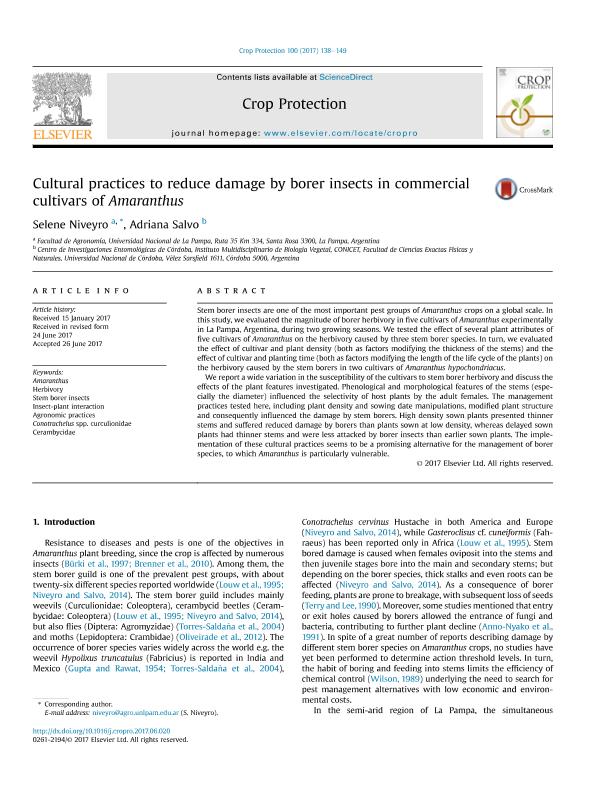Mostrar el registro sencillo del ítem
dc.contributor.author
Niveyro, Selene Leonor

dc.contributor.author
Salvo, Silvia Adriana

dc.date.available
2018-10-23T13:31:32Z
dc.date.issued
2017-10
dc.identifier.citation
Niveyro, Selene Leonor; Salvo, Silvia Adriana; Cultural practices to reduce damage by borer insects in commercial cultivars of Amaranthus; Elsevier; Crop Protection; 100; 10-2017; 138-149
dc.identifier.issn
0261-2194
dc.identifier.uri
http://hdl.handle.net/11336/62928
dc.description.abstract
Stem borer insects are one of the most important pest groups of Amaranthus crops on a global scale. In this study, we evaluated the magnitude of borer herbivory in five cultivars of Amaranthus experimentally in La Pampa, Argentina, during two growing seasons. We tested the effect of several plant attributes of five cultivars of Amaranthus on the herbivory caused by three stem borer species. In turn, we evaluated the effect of cultivar and plant density (both as factors modifying the thickness of the stems) and the effect of cultivar and planting time (both as factors modifying the length of the life cycle of the plants) on the herbivory caused by the stem borers in two cultivars of Amaranthus hypochondriacus. We report a wide variation in the susceptibility of the cultivars to stem borer herbivory and discuss the effects of the plant features investigated. Phenological and morphological features of the stems (especially the diameter) influenced the selectivity of host plants by the adult females. The management practices tested here, including plant density and sowing date manipulations, modified plant structure and consequently influenced the damage by stem borers. High density sown plants presented thinner stems and suffered reduced damage by borers than plants sown at low density, whereas delayed sown plants had thinner stems and were less attacked by borer insects than earlier sown plants. The implementation of these cultural practices seems to be a promising alternative for the management of borer species, to which Amaranthus is particularly vulnerable.
dc.format
application/pdf
dc.language.iso
eng
dc.publisher
Elsevier

dc.rights
info:eu-repo/semantics/openAccess
dc.rights.uri
https://creativecommons.org/licenses/by-nc-sa/2.5/ar/
dc.subject
Agronomic Practices
dc.subject
Amaranthus
dc.subject
Cerambycidae
dc.subject
Conotrachelus Spp. Curculionidae
dc.subject
Herbivory
dc.subject
Insect-Plant Interaction
dc.subject
Stem Borer Insects
dc.subject.classification
Otras Ciencias Biológicas

dc.subject.classification
Ciencias Biológicas

dc.subject.classification
CIENCIAS NATURALES Y EXACTAS

dc.title
Cultural practices to reduce damage by borer insects in commercial cultivars of Amaranthus
dc.type
info:eu-repo/semantics/article
dc.type
info:ar-repo/semantics/artículo
dc.type
info:eu-repo/semantics/publishedVersion
dc.date.updated
2018-10-22T19:54:45Z
dc.journal.volume
100
dc.journal.pagination
138-149
dc.journal.pais
Países Bajos

dc.journal.ciudad
Amsterdam
dc.description.fil
Fil: Niveyro, Selene Leonor. Universidad Nacional de la Pampa. Facultad de Agronomia. Cátedra de Edafología, Cons., Manejo y Fert.de Suelos; Argentina
dc.description.fil
Fil: Salvo, Silvia Adriana. Consejo Nacional de Investigaciones Científicas y Técnicas. Centro Científico Tecnológico Conicet - Córdoba. Instituto Multidisciplinario de Biología Vegetal. Universidad Nacional de Córdoba. Facultad de Ciencias Exactas Físicas y Naturales. Instituto Multidisciplinario de Biología Vegetal; Argentina
dc.journal.title
Crop Protection

dc.relation.alternativeid
info:eu-repo/semantics/altIdentifier/url/http://linkinghub.elsevier.com/retrieve/pii/S0261219417301801
dc.relation.alternativeid
info:eu-repo/semantics/altIdentifier/doi/http://dx.doi.org/10.1016/j.cropro.2017.06.020
Archivos asociados
